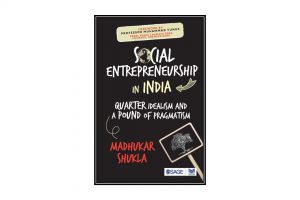Sukhpal Singh (2023)
Orient BlackSwan
ISBN: 9789354424656
Pages: 208
Price: INR 580
Agriculture has always served as the backbone of Indian economy, offering livelihoods to more than 50 percent of the population, either directly or indirectly. With the global population expanding rapidly, the pressure on agriculture to sustain and feed the growing populace is increasing. Farmers play an indispensable role, serving as the fundamental pillar upon which the entire structure of agriculture relies as they are the ones producing and selling. The agrarian market involves numerous buyers and sellers through whom the produce moves, enabling farmers to earn their livelihoods.
The agricultural market in India faces several challenges, with the primary concern being the inadequate remuneration received by farmers due to an excess of stakeholders in the supply chain. This surplus of participants makes the channel inefficient, leading to higher prices. Hence, regulation of the agricultural market becomes imperative.
The government has consistently implemented diverse policies to ensure fair and remunerative prices for farmers, aiming to maintain market stability. The enactment of the APMC Act was a significant approach to shield farmers from malpractices of traders. The regulation of the agricultural market in India has undergone multiple reforms. While these measures were initially intended to safeguard farmers from exploitation, ironically, they themselves became a source of exploitation.
This book, Regulating Agricultural Markets in India; A Smallholder Perspective by Prof. Sukhpal Singh intelligently presents the inception of the APMC Act, its diverse loopholes, the reforms introduced through the Model Act, the now-repealed New Farm Bills, and the critical questions surrounding Minimum Support Price (MSP). There was considerable ambiguity surrounding the new farm bills, especially on the necessity of Minimum Support Price (MSP). This book addresses a number of questions, catering not only to academicians, policymakers, and students but also to ordinary people who avidly follow daily news and are overwhelmed with information. The chapters are intricately woven in a systematic manner, creating the sensation of listening to a narrative about marketing in India.
It is widely acknowledged that merely 6 percent of farmers throughout India are benefiting from Minimum Support Price (MSP), and these are concentrated in Punjab, Haryana, certain areas of Uttar Pradesh, and Rajasthan. However, the author has elucidated that farmers from 15 states were, in fact, receiving MSP. The author has drawn attention to several thought-provoking ideas, such as the potential role that small farmers could play in shaping the future of India, and the revelation that 40 percent of Indian farmers are not interested in farming. The younger generation does not see farming as a viable career option. Despite the entire system’s efforts to double the income of farmers, it is indeed surprising that even today’s farmers – from the older generation – do not wish to continue in this profession themselves.
Providing a chapter-wise review of the book is superfluous, given the multitude of arguments addressed in each chapter, making it impractical to cover all aspects in this review. The author extensively delves into the subject of Contract Farming, elucidating its role in the APMC Act and other reforms, for instance, Punjab’s (repealed) separate contract farming act, 2013. Prof. Singh also presents examples from countries such as France, Panama, Spain, and many more. The book consistently provides readers with a plethora of facts, figures, and numerous illustrative examples on the topic. The author has very cleverly analyzed the gaps in different regulatory frameworks.
The Indian government introduced three new farm bills in 2020: the Farmers’ Produce Trade and Commerce (Promotion and Facilitation) Bill, the Farmers (Empowerment and Protection) Agreement on Price Assurance and Farm Services Bill, and the Essential Commodities (Amendment) Bill. These bills aimed to liberalize agricultural markets, provide farmers with more options for selling their produce, and attract private investment into the sector. Nevertheless, this new initiative drew the ire of farmers which led to its repeal. The enactment and subsequent repeal of the farm bill had its own consequences. The author scrutinizes the inequity in the MSP-based public-private system for certain farmers and states, the misunderstood connection between the new APMC Mandi Bypass Act and MSP-oriented public procurement, apprehensions regarding Union Government agencies such as FCI and CCI altering their procurement jurisdictions, the determination of reference prices for private entities, the general decline of APMC mandis, and the aftermath of the new acts on the APMC mandi’s business, highlighting the extent of its impact.
Prof. Singh has examined the issue of legal status to the MSP. He has likened a crop in the mandi to a dead body which cannot be brought back to life or held down for long. He has explained various issues with the current MSP system, like it is announced for 23 crops but procurement at MSP is actually done only for two to three crops, low awareness of MSP across crops, very small proportion of the total marketed surplus sold in APMC, accessed by only large farmers, etc. The book has also highlighted the recommendations of prominent committees such as the Shanta Kumar Committee which suggested ending open-ended procurement by FCI and CACP and NITI Aayog, suggesting a minimum reserve price, which could be the starting point of auctions at mandis, instead of MSP. Very brilliantly he has calculated the whole procurement cost to government and has addressed the issue of miscalculations done by other researchers. He asserted that the government doesn’t necessarily have to buy the entire agricultural yield from farmers at Minimum Support Price (MSP); just acquiring a smaller portion of the overall supply can effectively regulate market prices. This chapter concludes with an answer to the question on the need for legality of MSP. The book presents a multitude of arguments all through, each of which is methodically addressed and answered.
Regulating Agricultural Markets in India serves as a valuable resource for academicians, teachers, scientists, and students. It is equally helpful for non-academic individuals seeking clarity on the new farm laws and legality of MSP, providing a reliable means to dispel rumors. It is a one-stop place where you can find real and trustworthy information, all presented in an easy-to-understand way.
Snehal Mishra
 Dr Snehal Mishra is Assistant Professor, International Agribusiness Management Institute, Anand Agricultural University, Anand, Gujarat (snehalmishra130@gmail.com)
Dr Snehal Mishra is Assistant Professor, International Agribusiness Management Institute, Anand Agricultural University, Anand, Gujarat (snehalmishra130@gmail.com)





Add Comment